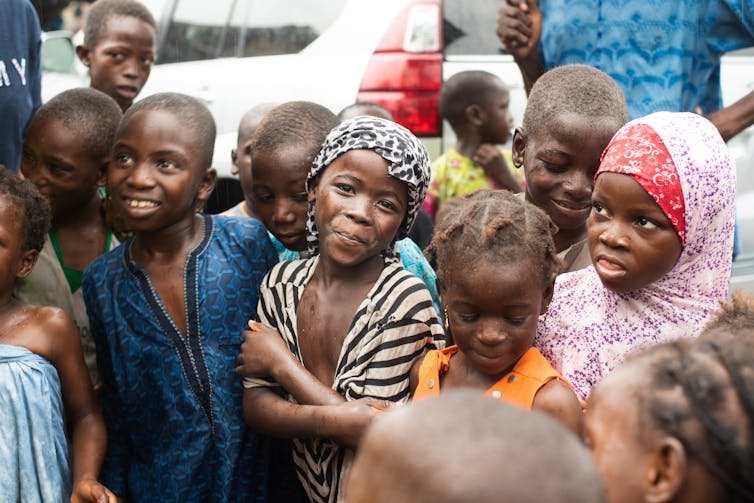
Shutterranger/Shutterstock
Daniel Ogunniyi, University of Nottingham
It is 30 years since countries across the world adopted the UN Convention on the Rights of the Child . Yet, to date, the terms it sets out to protect children remain far from reality in many countries.
This is true in Nigeria too, even though its federal government ratified the convention in 1991.
After years of complex negotiations, Nigeria passed a new law – the Child Rights Act – 16 years ago. The law was designed to bring the country into line with the provisions of the convention. The act deals with a range of threats that children might face. This includes child labour and other forms of exploitative practices.
Nigeria has also passed other non-specific child laws that protect children. These include the Labour Act and the Trafficking Act.
Despite these additional statutes, huge gaps remain.
The biggest is that the Convention on the Rights of the Child incorporated through the Child Rights Act does not apply across the country, only 25 states have adopted the Act.
The reason for this is that Nigeria is a federation comprising 36 legally equal states and the Federal Capital Territory. Each state has an independent legislature. Certain laws, including those that pertain to children’s rights – even after they’ve been passed by the federal government – don’t become effective until they’ve been adopted by the lawmakers in each state.
The reason for the hold up in the 11 states is that they disagree with provisions in the act which they argue are in conflict with religious and cultural norms. All 11 states are in the northern part of Nigeria.
Objections
Nigeria’s population is roughly split between a majority Muslim north and a largely Christian south, with a small fraction of the population identifying with indigenous African religions. But it’s important to note that the country can’t be neatly divided into a Muslim north/Christian south binary, as there are pockets of Christians in the north, just as there is a sizable number of Muslims in the south. On top of this, worshippers of traditional African religions cannot be tied to any particular region in the country.
The states that have yet to sign the Child Rights Act have laid down specific grounds for rejecting the law.
The major objections include the fact that the act:
-
prohibits child marriages.
-
prohibits marriage to members of an adoptive family, and
-
defines a child as anyone below the age of 18.
The prohibition of child marriage in the statute responds to dominant practices whereby younger girls are married off to older men, which often skews power relations in favour of those men. Evidence suggests that domestic violence by an intimate partner is usually more widespread among girls than among older women who are able to provide informed consent.
Also, there is often a strong correlation between child marriage and exposure to health risks, including complications during pregnancy and childbirth. The Word Health Organisation, for instance, notes that adolescent pregnancy is one of the major contributors to maternal and child mortality.
Complications arising from pregnancy and childbirth are regarded as the leading cause of death among girls 15 to 19 year old globally. Apart from its health consequences, adolescent marriage could also have socioeconomic effects on girls.
With regard to education for instance, leaving school could be the rational choice for pregnant girls, which could, in turn, deny them economic opportunities and perpetuate a cycle of poverty. The WHO estimates that child marriage reduces future earnings of girls by around 9%.
The 2008 Nigerian Demographic and Health Survey estimated that 48% of girls in northern Nigeria were married off by the age of 15, while 78% were married before their 18th birthday. The survey put the median age of marriage in the north-western region at 15.2 years of age. The most recent demographic survey released last month, does not include this data.
Regarding the prohibition of marriage to adoptive parents, it is worth noting that although the concept of adoption is generally not recognised under Islamic law, the provision of the Child Rights Act on this subject is considered by many states in northern Nigeria to be far reaching.
Under Islamic law, “kafalah” is the principle governing relations between parents and adopted children. It draws a distinction between biological and non-biological children, and considers the latter as maintaining blood relations to their original family, and consequently may be married to members of the adoptive family.
Therefore, political leaders in northern Nigeria perceive the Child Rights Act as challenging a practice legitimised by religion – Chapter 33: 4–6 of the Qur’an generally affirms as valid a marriage between an adoptive parent and an adopted child as there is no blood relations between them.
However, this practice could well mask child exploitation. Parents could use their position of power subjectively, thereby exposing children to similar risks associated with child marriage. Childhood and vulnerability are intrinsically tied together, and every child must be accorded legal protection. Moreover, it is important that child rights laws apply equally across Nigeria, as opposed to the current practice where children within the country are subject to different legal standards simultaneously.
The way out
All is not lost. Nigeria’s Labour Act and the Trafficking Act could offer some protection to children across the country, especially in the areas of child labour and child trafficking.
Nevertheless, the vulnerabilities of children and their susceptibility to exploitation for example, through child marriage, demand more sustained efforts. Pressure should continue to be exerted on the 11 states that have yet to re-enact the Child Rights Act to take the best interest of children into account.![]()
Daniel Ogunniyi, Research Fellow in Anti-Slavery Legislation and Governance, University of Nottingham
This article is republished from The Conversation under a Creative Commons license. Read the original article.
 NewsProbe News from Nigeria and Around the world
NewsProbe News from Nigeria and Around the world


